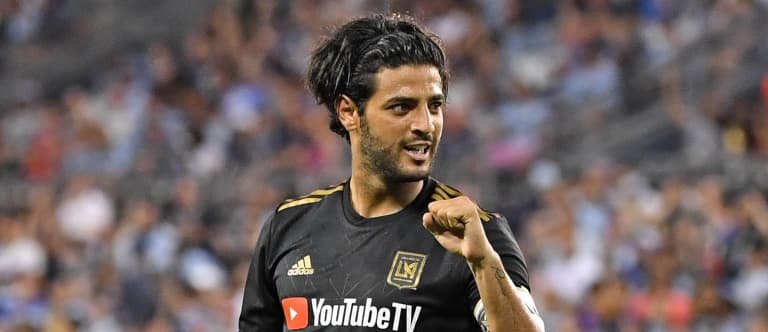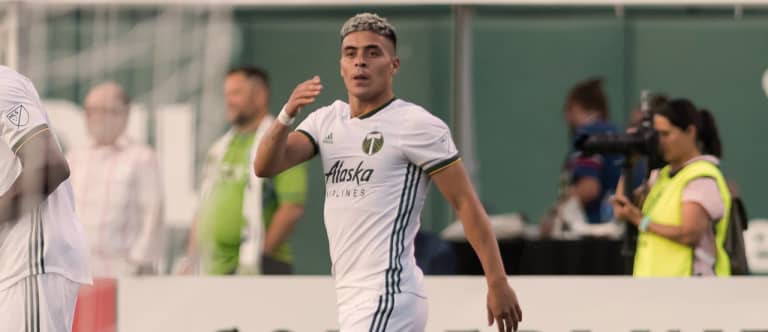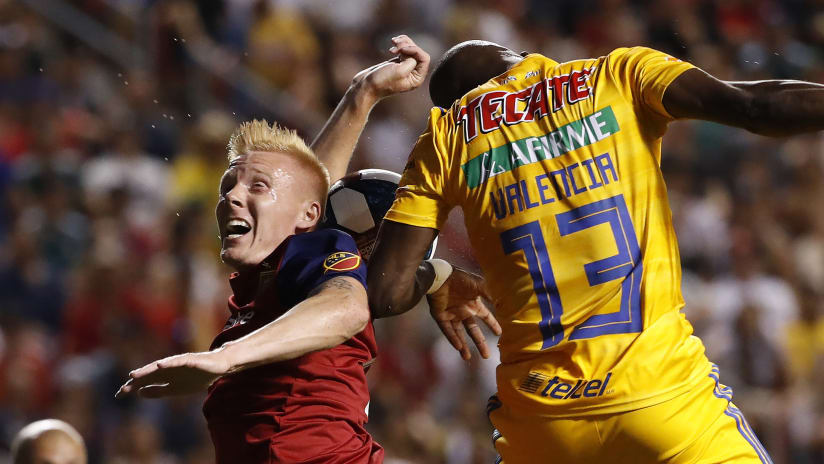Over his 13 years as a Houston Dynamo executive, Chris Canetti did plenty of searching for big signings from Mexico, and for obvious reasons. With one of the largest Latino populations in the United States and the majority of them of Mexican descent, La Naranja’s home market seemed ripe for a prominent player from Texas’ southern neighbor, ideally one with Mexican national -team pedigree.
Easier said than done.
“I can tell you that every year, probably, there were serious conversations over specific Mexican players that we wanted to bring in,” Canetti, who departed the Dynamo last fall to take up a role with Houston’s World Cup 2026 bid committee, told MLSsoccer.com this week.
“We really only had two.”
Those would be Luis Angel Landin, Houston’s first-ever Designated Player, and Erick “Cubo” Torres, both strikers, both rising El Tri prospects, both DPs. Alas for the Dynamo, neither lived up to expectations in the Bayou City.
“It’s one thing to have a player that’s representative of the community, but they need to play well to really excite that community and make a difference on the field,” noted Canetti, citing Liga MX’s lofty wages as a key obstacle. “Unfortunately in both of those situations it didn’t happen. But there was always an eagerness to pursue those opportunities.”
Fast-forward to today, and such acquisitions have become more attainable, more commonplace and more impactful, thanks to evolving attitudes on both sides of the border.
LAFC superstar and MLS Golden Boot leader Carlos Vela is the best-known of today's crop, while Jonathan dos Santos and Marco Fabian are El Tri regulars and Uriel Antuna was that program's breakout star in their run to this summer's Gold Cup trophy. And non-Mexican imports from Liga MX like Maxi Moralez, Raul Ruidiaz and Brian Fernandez are some of MLS’s most feared players.

Carlos Vela | USA Today Sports Images
“There’s a lot more respect for the league. You look at the growth of MLS and it’s not only the investment on the players side, it’s the investment in the league and the status of the league,” said Portland Timbers GM/president of soccer Gavin Wilkinson.
“It is seen as a viable place for a young and upcoming player to play, and have a phenomenal career and potentially move to Europe. I think the perception has changed. Previously you were looking at some of the bigger deals, the DP deals that brought a Mexican player to the US. Now there’s a lot more movement at the lower levels.”
The new Leagues Cup, which debuted this week with four MLS-vs.-Liga MX matchups, has drawn mixed reactions in some US and Canadian circles, but is best viewed within this wider shift.
While Mexican teams have traditionally been a cut above on the pitch – according to ESPN's Jeff Carlisle, Liga MX is 28-14-12 vs. MLS in Concacaf Champions League play since 2012 – their executives see much they can learn from MLS off of it.
“I think they realize that there are just things that north of the border, Major League Soccer is just better at – they make an event out of everything,” said Herculez Gomez, who played in both MLS and Liga MX before becoming an ESPN pundit after retirement. “Any type of owners I speak to in Mexico, that’s the one thing they love about MLS, is their ability to make events even bigger.”
The most obvious manifestations of the growing partnership between the two leagues are the Leagues Cup and Campeones Cup, the annual meeting of their respective champions that launched last year and returns with Atlanta United vs. Club America next month. And for all the concerns about roster depth, schedule congestion and the legitimacy of brand-new competitions, those with experience in both nations – like San Jose Earthquakes coach Matias Almeyda – are optimistic, and suggest that this is just the start.
“These events,” LA Galaxy GM Dennis te Kloese, who’s also worked at Chivas Guadalajara, Chivas USA, Tigres UANL and the Mexican federation, told MLSsoccer.com, “for our players, for our staff, they give something extra. It’s an international game, it’s a very good opponent, they have a very deep roster with good players, always. And gives us a good benchmark of where some of our players are.
“Now there’s always a challenge with these events regarding the MLS schedule, the calendar, that we run into. But it’s OK. I have seen that there is some excitement within the team to go out and play [Club Tijuana] and see how we do.”
The Galaxy outlasted Xolos in a dramatic penalty-kick shootout on Tuesday, the sole MLS side to advance to the League Cup semifinals. While LA, the Dynamo, Chicago Fire, and Real Salt Lake all mixed plenty of reserves into their starting lineups, their Mexican counterparts fielded mostly full-strength XIs.
Given the fearsome quality sides like America and Tigres boast, that posed a steep challenge for the MLSers. Yet all four matches were closely contested and drew decent midweek crowds. It's already been announced that next year's edition will double in size to 16 teams.
“On the competitive side and technical side, there are still obviously bridges to build, gaps to be filled,” said te Kloese, “some things that obviously still need to grow on our end here in MLS to be able to compete consistently with the Mexican teams. They have deep rosters, they have a different set of rules and regulations than we are under here and that sometimes benefits them on the field a little bit. But I think little by little we’re getting closer.”
Leagues Cup has drawn comparisons to the old SuperLiga, a similar concept that ran from 2007 to 2010 and is generally remembered as an unloved stepchild of a competition. But both tournaments offer tangible benefits for MLS teams seeking to introduce themselves to a different demographic. Doing so by going toe-to-toe with Liga MX royalty is a risk, but one usually worth taking.
“I can tell you that playing in the SuperLiga against these brands from Mexico were very, very useful in us building the brand and establishing credibility as a club,” recalled Canetti, whose Houston teams took part in three of the four editions of SuperLiga. “To go on the field in a tournament and play Pachuca or Tigres or Club America or whoever it might be, and in some cases to come away with results, I think established our club and our league on a certain level to an audience we needed to establish that with.
“Any cup, any tournament, no matter where it is around the world, requires time to develop,” he added. “So people may be skeptical or whatever in year 1, but over the course of the next couple of years, it could have the opportunity to become something that people look forward to every year, that is exciting, is meaningful, is drawing big television audiences or big crowds, big revenue. You have to start somewhere.”
Noting the two countries’ wider history of national-team showdowns, Gomez phrased it in even blunter terms.

Brian Fernandez is an example of the growing cross-pollination between the two leagues | USA Today Sports Images
“People need to realize: people enjoy these things,” he said. “And as long as they enjoy them, as long as the Mexican national team keeps coming to the States and selling out stadiums, as long as these Mexican clubs come to the States and sell out stadiums, as long as they have a rivalry between the US men’s national team and Mexico, between MLS and Liga MX exists, there is money to be made.”
The cross-border cross-pollination looks likely to continue, if not accelerate, especially with both leagues growing more comfortable shopping one another for quality talent.
“The assimilation – they’re already in Mexico, there’s a knowledge of MLS that maybe exists moreso than if a player was in Europe or other countries, because of the amount of MLS games that are shown in Mexico, because of the awareness of the league,” said Wilkinson. “I think players are very open to it and know more about the league, which hopefully makes the process of bringing the player in a little bit smoother.
“Statistically we’re able to cross over a little bit more between the two, to look for similarities. We have a lot more information coming out of Mexico with player identification, with KPIs [key performance indicators], with just the analytics that we do, than out of several other countries.”
Portland’s Fernandez and recent New England Revolution acquisition Gustavo Bou are the most recent big-ticket transfers. Gomez, however, sees traffic flowing south as well, suggesting that MLS standouts can be tempting targets for Liga MX clubs.
“Look at [LAFC goalkeeper] Tyler Miller, for example,” said Gomez. “He’s absolutely crushing it statistically. His contract runs out at the end of the year. That’s a free transfer, that’s very, very appealing, especially in an era where Mexican goalkeepers and US goalkeepers aren’t what they used to be. That’s very appealing for teams down south.”
Those on the MLS side might not want to hear that. But it’s just one aspect among many of what appears to be a virtuous cycle of competition, comparison and cooperation that both parties see driving forward progress and mutual benefit.














